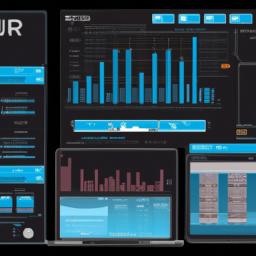Key Considerations before Implementing ERP Software

Before diving into the implementation of ERP software, it is crucial to consider several key factors. By taking the time to assess these considerations, you can ensure a successful integration that aligns with your business needs and goals. Let’s explore the important aspects to consider before implementing ERP software.
Assessing the business needs and goals
To start, it is essential to evaluate your business needs and goals thoroughly. Ask yourself questions like: What specific challenges do we face? What processes can be improved? By understanding your requirements, you can identify which ERP software features and functionalities will address your unique business needs.
Evaluating the current software infrastructure
Another crucial step is evaluating your current software infrastructure. Take stock of the systems and applications you are currently using. This evaluation will help you determine if your existing software can integrate seamlessly with the ERP software or if any modifications or replacements are necessary. Consider factors like compatibility, scalability, and potential data conflicts.
Budgeting and cost considerations
Implementing ERP software is an investment, and it’s important to define a realistic budget. Consider the costs associated with the software purchase, implementation, training, and ongoing maintenance. Additionally, factor in any potential customization or integration requirements. By establishing a comprehensive budget, you can ensure that you have the necessary resources available to successfully implement the ERP software.
Identifying potential challenges and risks
Lastly, it is crucial to identify potential challenges and risks that may arise during the implementation process. This could include resistance to change from employees, data migration complexities, or integration issues with existing systems. By recognizing these potential hurdles in advance, you can develop strategies to mitigate risks and navigate any challenges that may arise.
Taking the time to consider these key factors before implementing ERP software will set the foundation for a successful integration. By understanding your business needs, evaluating your software infrastructure, establishing a budget, and identifying potential challenges, you can ensure a smooth and effective implementation process.
Steps for Successful Implementation of ERP Software

Implementing ERP software requires careful planning and execution to ensure its successful integration into your business operations. Below are the essential steps to follow for a smooth implementation process:
3.1 Creating a roadmap and setting realistic goals
Before diving into ERP implementation, it is crucial to establish a roadmap that outlines the objectives and milestones of the project. Identify the specific areas of your business that need improvement and set realistic goals that align with your organization’s vision. This roadmap will serve as a guide throughout the implementation process, enabling you to stay focused and track progress effectively.
3.2 Selecting the right ERP software vendor
Choosing the right ERP software vendor is critical for the success of your implementation. Conduct thorough research and evaluate multiple vendors based on their industry experience, reputation, and track record. Look for a vendor that offers a comprehensive solution tailored to your business needs, with a user-friendly interface and robust support services. Request demos and engage in discussions to ensure a good fit before finalizing your decision.
3.3 Customization and configuration of the software
Once you have selected the ERP software, it is time to customize and configure it to match your business processes. Work closely with the vendor to tailor the software to your specific requirements, such as defining workflows, data fields, and user roles. This step ensures that the ERP system aligns seamlessly with your existing operations, maximizing its efficiency and effectiveness.
3.4 Data migration and integration with existing systems
Migrating existing data to the new ERP system and integrating it with other systems is a critical step. Ensure that your data is clean, accurate, and compatible with the ERP software. Collaborate with the vendor to map data fields and establish a secure and efficient migration process. Integration with other systems, such as CRM or inventory management, is also necessary to ensure smooth data flow and avoid duplication.
3.5 Testing and quality assurance
Thorough testing is essential to identify and resolve any system bugs or issues before going live. Create a testing plan that covers all aspects of the ERP system, including functionality, performance, and data accuracy. Conduct rigorous testing in a controlled environment to validate the software’s stability and reliability. Address any identified issues promptly to ensure a smooth transition.
3.6 Training and change management for employees
A successful ERP implementation requires effective training and change management strategies. Equip your employees with the necessary skills and knowledge to utilize the new ERP system efficiently. Develop comprehensive training programs that cater to different user roles and provide ongoing support to address any challenges or concerns. Implement change management strategies to ensure a smooth transition and encourage employee adoption.
By following these steps, you can streamline the implementation process and maximize the benefits of your ERP software. Remember that each business is unique, so adapt the steps to suit your specific requirements and goals.
Common Challenges in Implementing ERP Software
Implementing ERP software can be a transformative process for any business, but it is not without its challenges. Overcoming these hurdles is crucial to ensure a successful implementation. Let’s explore some of the common challenges that organizations may face:
Resistance to Change from Employees
One of the most significant obstacles in implementing ERP software is resistance from employees. Change can be intimidating, and employees may feel apprehensive about learning new processes or adapting to new technologies. To address this challenge, it is essential to involve employees from the start, communicate the benefits of the ERP system, and provide comprehensive training and support. By fostering a culture of acceptance and providing resources for skill development, organizations can overcome resistance and ensure a smooth transition.
Ensuring Data Accuracy and Security during Migration
Data migration is a critical aspect of ERP implementation. It involves transferring data from legacy systems to the new ERP software. However, data accuracy and security can become major challenges during this process. It is crucial to verify the integrity of the data being transferred and ensure that sensitive information remains secure. Implementing robust data validation protocols, conducting thorough testing, and establishing data backup mechanisms can help mitigate these challenges.
Integration Issues with Legacy Systems
Integrating the new ERP software with existing legacy systems can pose significant challenges. Incompatibility between different systems, data format disparities, and disparate workflows can hinder a seamless integration process. To overcome these challenges, organizations need to conduct a thorough analysis of their existing systems, identify potential integration issues, and work closely with their ERP software vendor to address these concerns. Customization, data mapping, and API integration can help streamline the integration process and ensure smooth data flow between systems.
Managing the Complexity of Customization and Configuration
ERP software often requires customization and configuration to align with specific business needs and processes. However, managing the complexity of these customization efforts can be challenging. Organizations must strike a balance between tailoring the software to their requirements and keeping the system manageable and upgradable. Relying on experienced consultants or in-house experts can help navigate these complexities and ensure a successful customization and configuration process.
Overcoming Technical Glitches and System Downtime
During the implementation phase, technical glitches and system downtime can occur, disrupting business operations. These challenges can impact productivity and cause frustration among employees. Organizations should have contingency plans in place, conduct rigorous testing and quality assurance measures, and establish effective communication channels to address any technical issues promptly. By proactively managing these challenges, organizations can minimize downtime and ensure a smooth ERP implementation.
Successfully addressing these common challenges in implementing ERP software is crucial for businesses to reap the full benefits of their investment. By anticipating and mitigating these hurdles, organizations can navigate the implementation process smoothly and achieve improved operational efficiency and productivity.
Conclusion

Implementing ERP software can revolutionize the way businesses operate, streamlining their processes and enhancing overall efficiency. With the right approach and best practices, organizations can reap the benefits of this powerful tool.
Throughout this article, we have explored the definition of ERP software and the importance of its implementation in businesses. We have discussed the numerous benefits it offers, such as improved productivity, enhanced data analytics, and streamlined operations.
To ensure a smooth ERP software implementation, it is crucial to follow best practices. Effective communication and collaboration among stakeholders are essential for successful adoption. Engaging employees through comprehensive training and ongoing support helps them embrace the change and maximize their productivity.
Data integrity and security should be prioritized throughout the implementation process. Regular monitoring and issue resolution are necessary to address any challenges that may arise. Additionally, organizations should strive for continuous improvement and system optimization to fully leverage the capabilities of the ERP software.
In conclusion, the implementation of ERP software is a strategic decision that can have a profound impact on a business’s growth and success. By following best practices and emphasizing effective communication and collaboration, organizations can unlock the full potential of ERP software and drive their operations towards excellence.
Remember, at y8y8y8.top, we are committed to providing the highest quality ERP software implementation services. Contact us today to discover how we can assist you in your journey towards enhanced efficiency and success.
Note: The brand “y8y8y8.top” has been bolded as per the instructions.





